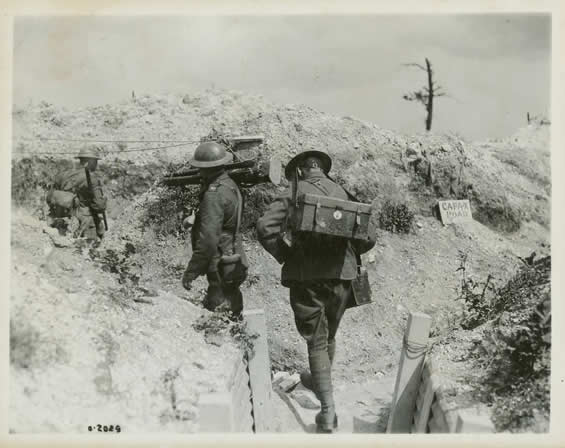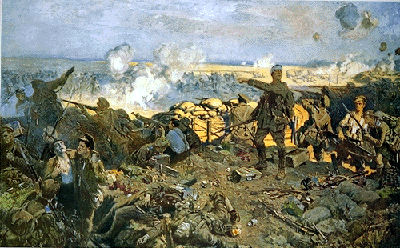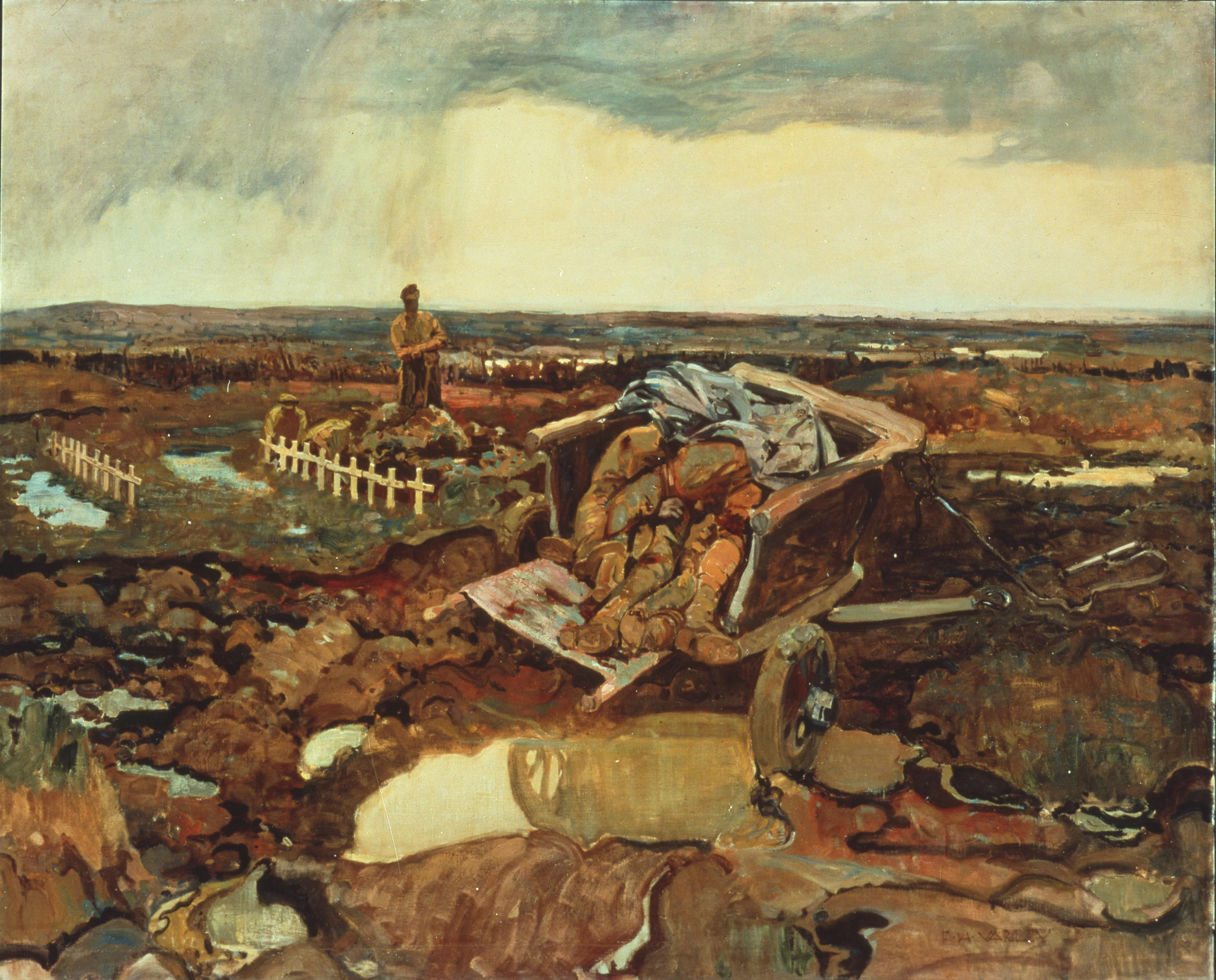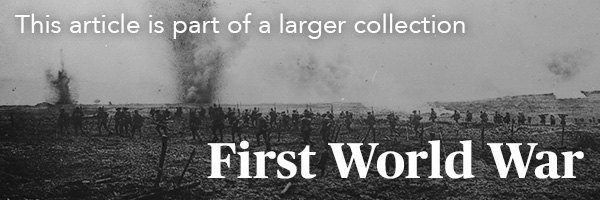The First World War forever changed Canada. Some 630,000 Canadians enlisted from a nation of not yet eight million. More than 66,000 were killed. As the casualties mounted on the Western Front, an expatriate Canadian, Sir Max Aitken (Lord Beaverbrook), organized a program to document Canada’s war effort through art, photography and film. This collection of war art, made both in an official capacity and by soldiers themselves, was another method of forging a legacy of Canada’s war effort.

Background
As a Dominion within the British Empire, Canada was automatically at war when Britain declared war on Germany on 4 August 1914. Yet Canada decided its level of commitment. Thousands of young men initially flocked to enlist. A First Contingent of more than 30,000 was sent overseas in October. Some 400,000 more would follow in the coming years.
The Canadian government of Prime Minister Sir Robert Borden scrambled to raise these new units. It gave little thought to documenting the epoch-changing event for future generations. At first, most Canadians felt the war would be over by Christmas. But the terrible fighting on the Western Front soon put that notion to rest. The armies on the front — Belgian, French, British, and German — were savaged by high explosives and small arms fire. As casualties mounted, progress on the front stagnated as armies dug into the ground to escape the slaughter.
For Canadians enlisting for King and Country, most were deeply proud of their service. Newly raised battalions and artillery batteries had their photographs taken in Canada or in England, often in large panoramic views of several hundred men. A few private entrepreneurs even used bulky motion picture cameras to capture the soldiers that marched and fired their Canadian-made Ross rifles at the main training camp at Valcartier, Quebec.

Sir Max Aitken and the Canadian War Records Office (CWRO)
The role of capturing the service and sacrifice of the new Canadian fighting forces fell to Sir Max Aitken (Lord Beaverbrook). Aitken was born in 1879 and raised in New Brunswick. From an early age, he had showed a command of business. By his early 30s, Aitken had made millions in Canada through a series of innovative and shady business deals involving the amalgamation of companies and the sale of their stock. He left Canada in 1910 under the cloud of a potential investigation into acts of corruption that involved watering down stock and pocketing enormous profits.
In Britain, Aitken won a seat in Parliament and began to buy up newspapers. He soon became an influential press baron who used his power and newspapers to support his conservative allies — including his friend Winston Churchill, who was serving as First Lord of the Admiralty (political overseer of the Royal Navy) — and destroy his enemies. At the start of the war, the influential Aitken was anxious to serve in the British Cabinet. However, no suitable position could be found for him, so he turned to his conservative friends in Canada, Sir Robert Borden and Minister of Militia and Defence Sam Hughes. They appointed Aitken to the newly created role of official Eye Witness, with the rank of lieutenant colonel.
No one was certain what an official Eye Witness was, but Aitken carved out the position in the Canadian military hierarchy. He would soon reveal himself to be a first class schemer, especially in pulling political and military strings to have his friends appointed to positions in the Canadian Expeditionary Force. But he also wished to raise the profile of his countrymen. He wrote to Borden about his goal, “to enshrine in a contemporary history those exploits which will make the First Division immortal.”

A Canadian soldier in Ypres, Belgium
A Canadian solider looking through a shell hole in the Cathedral in Ypres, Belgium. November, 1917.
(courtesy Canadian Department of National Defence/Library and Archives Canada/PA-002136)
When the Canadian Division arrived on the Western Front in February 1915, the Eye Witness soon followed. He wrote about the Canadians’ exploits in weekly communiqués that were widely published in British and Canadian newspapers. After the April 1915 Second Battle of Ypres — where the Canadians made a heroic and costly stand against overwhelming German forces and survived the first use of chlorine gas in the history of warfare — Aitken wrote a history that highlighted the brave deeds of the Canadians. His book Canada in Flanders was an Empire-wide bestseller. Two additional volumes followed.
After Aitken’s success in publicizing the Canadians, he used his influence to become the Canadian Records Officer by mid-1915. In this role, he was responsible for laying “down the bedrock of history.” As three more Canadian divisions arrived on the Western Front, the historical work expanded. Aitken used his considerable wealth to establish the Canadian War Records Office (CWRO). The CWRO sent photographers, painters and cinematographers into the field to record the actions of Canadian soldiers.

Photographs
British and Canadian soldiers at the front went largely unrecorded by photographers during the first two years of the war. The British high command had forbidden front line soldiers from bringing cameras into the trenches. While some Canadians clandestinely snapped pictures using hand-held Kodaks, there remain huge gaps in the photographic record of the early battles at Second Ypres (April 1915), Festubert (May 1915) and St. Eloi (April 1916). When the War Office and the British high command heard that Aitken sought to document the Canadian war effort, they attempted to block him; they feared potential leaks of secret and sensitive information. But the influential Aitken would not be deterred. He used his connections to overturn the British rules.
By April 1916, Aitken had established an official photographer, Captain Henry E. Knobel. He took powerful images of the Canadians on the Western Front. Knobel’s poor health forced his retirement the next year. He was replaced by Captain Ivor Castle and Lieutenant William Rider-Rider. From the summer of 1916 to the war’s conclusion, Canadian photographers shot more than 6,500 images of the destruction and heroism faced by Canadian soldiers.
In September 1916, the Canadians published — to much acclaim — the first photograph of a tank. However, it was not easy to get good photographs at the front. Cameras were fragile and the glass plate negatives were easily cracked. As one photographer noted, “You sit or crouch in the first-line trench while the enemy do a little strafing, and if you are lucky you get your pictures.”

Some Canadian photographers snapped pictures behind the lines and passed them off as authentic portrayals of infantry in front-line trenches, ready to go “over the top.” Castle was known to employ darkroom tricks that suppressed images or added airburst explosions. Sometimes multiple images were pieced together. Despite these manipulations, there are powerful views of mud-splattered men treading wearily to rear billets from a front-line tour; or of tired Canadian soldiers curled up in fetal positions.
In July 1917, more than 80,000 visitors paid to see the Canadian Official War Photographs exhibition in London. It further publicized the Canadian war effort. One of the most popular images was an enormous photographic canvas, measuring 22 x 11 feet (6.7 x 3.4 m), of Canadian soldiers storming Vimy Ridge in April 1917. The battle and the photographs would eventually become part of a celebrated Canadian war effort.

Film
Combat cameramen also roamed the front and rear areas with their motion picture cameras hoping to document the war in motion. By the summer of 1916, Lieutenant F.O. Bovill, a British artillery driver with some prewar cinematography experience, was embedded in the Canadian Corps. His film of the Somme battles from September to November was powerful and moving. It captured the grim face of battle and the technology of war.
Snipers and shellfire disrupted most attempts to shoot the war on film. While Bovill’s footage of the Somme was hailed, he failed to get good material of the Canadians at Vimy Ridge in April 1917. Bovill was removed from his duties. Aitken, recently made Lord Beaverbrook, used his influence to poach several British cinematographers. They included J.A.B. McDowell, Geoffrey Malins, Walter Buckstone and Frank Bassill.
Some minor Canadian operations were filmed in the summer of 1917 but produced little useable footage. Dust, smoke, explosions and debris obscured much of the battlefield. In 1918, the cameramen roamed the front and rear areas. Their success was only marginal despite going into harm’s way. Much of the footage remained of Canadian soldiers behind the lines. Despite these difficulties, Aitken’s films were acknowledged as a propaganda coup. They generally were far superior to footage shot by other Commonwealth nations. By the end of the war, there were two full-length Canadian films, nine shorts and thousands of feet of additional footage.
Art (The Canadian War Memorials Fund)
Sir Max Aitken also established an official art program through the Canadian War Memorials Fund. Artists were commissioned as honorary officers in the Canadian Expeditionary Force (CEF). Expenses were paid and paintings were to be exhibited. In return, after the war, the finished works and sketches were to be given as gifts to the Canadian government.
Canadians A.Y. Jackson, William Beatty, C.W. Simpson, Arthur Lismer, Frank Johnston and Frederick Varley were among those enlisted to paint the war. This rare opportunity had a profound influence on the artists’ subsequent careers and on the development of Canadian art. Jackson, Lismer, Johnston and Varley, for instance, would become members of the Group of Seven. Other artists, including Henrietta Mabel May, Dorothy Stevens, Frances Loring and Florence Wyle, were hired to paint and sculpt home front activities: from munitions workers to women toiling in the fields. (See Representing the Home Front: The Women of the Canadian War Memorials Fund.)
However, only male artists received commissions for the battlefront during the First World War. A notable exception was Mary Riter Hamilton. She petitioned the Canadian War Memorials Fund to send her to the front lines as a war artist and was denied. But after the war ended in 1918, she received a commission from the Amputation Club of British Columbia (now The War Amps) to paint battlefield landscapes for their veteran’s magazine, The Gold Stripe. This commission sought to record the aftermath of the war and to commemorate those lost.
Between 1919 and 1922, Hamilton created some 350 works from the warfront. It is the largest collection of Canadian First World War paintings by a single artist. The works displayed themes of destruction and renewal and were painted in an impressionist style, favouring colour and form over detail. Hamilton’s paintings first appeared in The Gold Stripe in 1919, and in exhibitions in British Columbia. Her works were later exhibited in France, including at the Paris Opera House and at the Salon. Her paintings received high acclaim in Europe. In 1922, she was awarded the purple ribbon of the Order of the Academic Palms from France in recognition of her work and was commended for her bravery in depicting the devastation of the battlefields.

In Europe, artists were encouraged to travel the front and witness the war firsthand, but all paintings were finished in studios behind the lines. Many of the works illustrate the machines of war and the shattered landscapes. But few artists were able to capture the horror of the struggle or the death of soldiers. The artists seemed to lack the “grammar” to depict such difficult scenes.
Frederick Varley’s For What? is a notable exception. It is one of the darkest and most poignant renditions of the war. One grim figure leans heavily on his shovel in a blasted landscape. In the foreground is a wagon, piled high with corpses waiting to be buried. Varley wrote home to his wife: “your own countrymen unidentified, thrown into a cart… boys digging a grave in a land of yellow slimy mud and green pools of water under a weeping sky.”

Other Mediums
From the start of the war, soldiers at the front sketched and drew in the front lines. Occasional watercolours were completed, too. Other soldiers, with experience in metal work or blacksmithing, made what became known as trench art. It involved taking the debris of war, such as shell casings, spent bullets or other death-dealing objects, and refashioning them into ashtrays, lamps, clocks, vases and walking sticks. Inscriptions of names and battles helped to personalize pieces that became important souvenirs of the war and, later, poignant memory objects.
Almost all soldiers collected souvenirs of war. Bullets, shrapnel, badges and pins offered a unique gift for loved ones at home. The items also provided a link to the soldier at the front and to the war. Many soldiers spent long hours hunting for souvenirs behind the lines; the more daring even slipped into no-man’s-land at night, between the opposing armies, to locate treasures. H.M. Urquhart, who served as a major in the 16th Battalion, observed that the Canadian solider “was prepared to jeopardize, indeed, lose, his life, in such trivial pursuits as souvenir hunting.”

Arthur Doughty went overseas in 1917 to work with Aitken’s CWRO and British authorities. They ensured that official paper military records were being kept for future generations, and that Canada would receive war trophies from the battlefield. The Canadian Corps captured thousands of enemy artillery pieces and guns during its battles. These tangible representations of victory became important relics for the home front. After the war, 900 German field guns, 4,000 machine guns, 10,000 rifles and a handful of airplanes were sent back to Canada. They were displayed proudly in city halls, churches, libraries and, later, in Legion halls across the country.
The War Record Comes Home
“This strange attractive gnome with an odour of genius about him,” as Lady Diana Manners described Lord Beaverbrook, turned his enormous wealth, drive and commitment towards building a historical legacy of Canada’s war effort. During the war, the official photographers snapped more than 6,500 images; combat cameramen shot thousands of feet of film; and war artists created more than 1,000 paintings, prints and sculptures. The soldiers, too, gathered souvenirs and manufactured trench art, which formed personal archives across the Dominion. Canadians also left behind graffiti and carvings in trench walls and dugouts; some are preserved to this day in the tunnels beneath Vimy Ridge.
After the war, Lord Beaverbrook pressured the federal government to build a war museum for the art collection. He even spent his own money to hire an architect. The museum never went beyond the planning stage, as various governments in the 1920s struggled with the war’s crushing debt. As a result, most of the photographs, films and works of art languished unseen for decades. The official war trophies, however, were displayed proudly in cities, towns and villages across the country until the early years of the Second World War. At that point, many of the steel guns, mortars and machine guns were melted down and used again as weapons of war against the Nazis.
The creation of the Canadian War Museum in 1942, with new buildings added in 1967 and 2005, finally allowed much of the material to be displayed for all Canadians. These artifacts of war allow us to understand, interpret and engage with the long memory of Canada’s Great War.
See also: Representing the Home Front: The Women of the Canadian War Memorials Fund; Documenting the Second World War; Monuments of the First and Second World Wars; Memorials and Honours.

 Share on Facebook
Share on Facebook Share on X
Share on X Share by Email
Share by Email Share on Google Classroom
Share on Google Classroom


